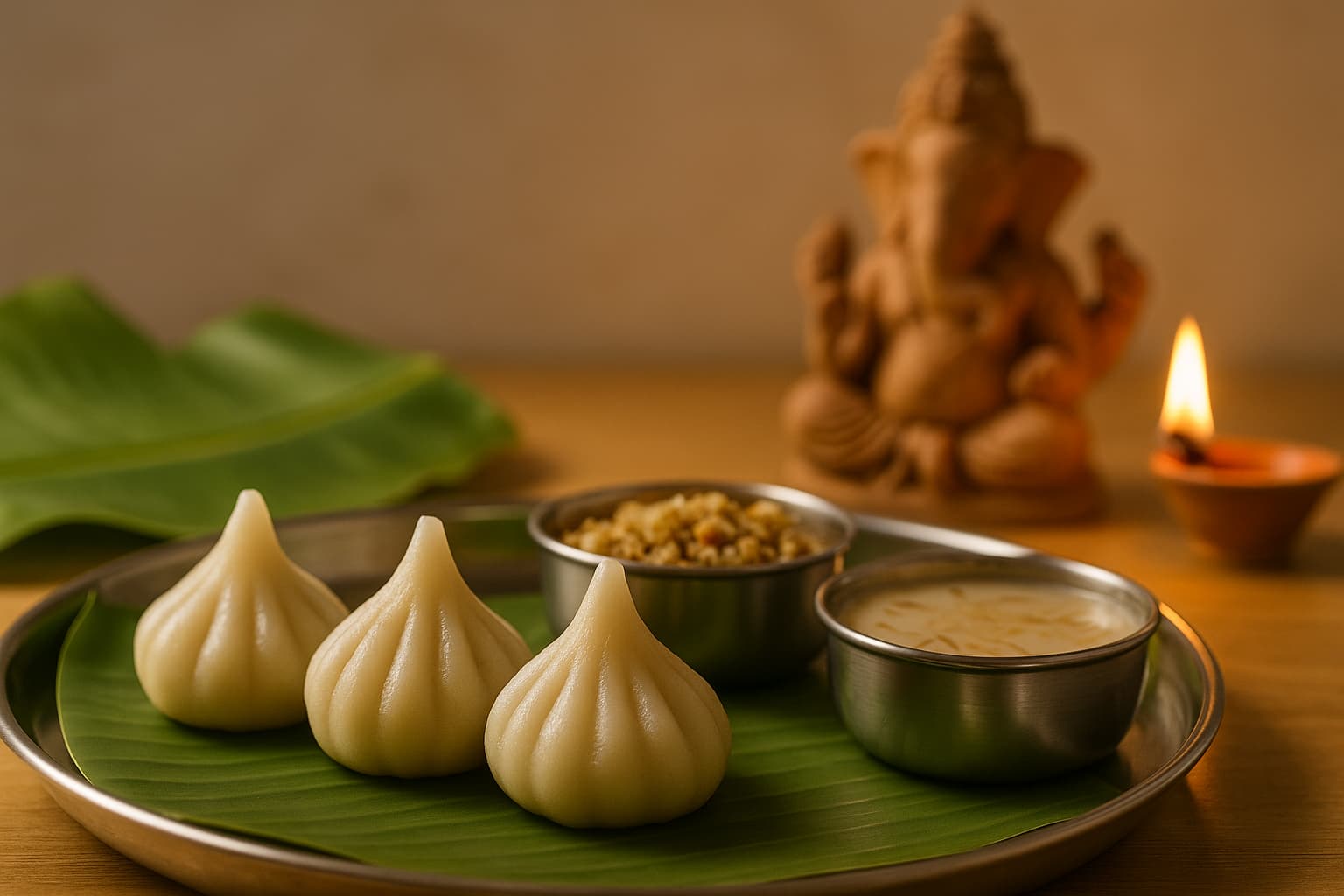Ganesh Chaturthi Dishes Karnataka: Naivedya, Menu & Tips
Ganesh Chaturthi dishes Karnataka traditions highlight satvik naivedya like Modaka/Kadubu, Karigadubu, Panchakajjaya, Holige, payasa and sundal. This guide shows what to cook, how to offer, and a simple one-day festival menu—covering regional styles from Udupi, Karavali and Malenadu to Bengaluru–Mysuru.
Tip: Offer sweets in odd numbers (many families choose 21), plate on banana/turmeric leaves, and distribute as prasada after the puja.
📝 Quick Overview — Ganesh Chaturthi Naivedya (Karnataka)
| Festival | Ganesh Chaturthi / Vinayaka Chaturthi (ಗಣೇಶ ಚತುರ್ಥಿ) |
| Core Naivedya | Modaka/Kadubu (steamed rice flour dumpling with coconut–jaggery), Panchakajjaya, Karigadubu, Holige (Kai/Bele), Payasa, Sundal/Usli |
| Best Time to Offer | Post-prāṇa pratiṣṭhā / pūja on Chaturthi day; many families also offer again in the evening before visarjana. |
| Satvik Rules | No onion/garlic; fresh ghee/sesame; clean cookware; avoid tasting before offering; use banana/turmeric leaves or clean steel plates. |
| Kannada Names | ಮೊದಕ/ಕಡುಬು, ಕರಿದ ಕಡುಬು/ಕರಿಜ್ಜಿಕಾಯಿ, ಪಂಚಕಜ್ಜಯ, ಹೋಳಿಗೆ (ಕಾಯಿ/ಬೇಳೆ), ಪಾಯಸ, ಸುಂಡಲ್/ಉಸಳಿ, ಚಕ್ಕುಲಿ, ಕೊಡುಬಳೆ. |
| Region-wise Touch | Udupi: panchakajjaya style; Karavali: patholi, kudubu; North Karnataka: holige, kadubu; Bengaluru–Mysuru: mixed plate+payasa. |
| Serving & Etiquette | Offer first to the deity with mantra; then distribute as prasada. Prefer eco-friendly plates; avoid plastic. |
| Pro Tip | Steam modaka with a slightly thicker edge seal to prevent cracks; use warm dough and cover to avoid drying. |
🍽️ Top 12 Ganesh Chaturthi Dishes (Karnataka)
Modaka / Kadubu (ಮೊದಕ/ಕಡುಬು)
Steamed rice-flour dumpling stuffed with coconut–jaggery. Considered Ganesha’s favorite; often offered in odd numbers (e.g., 21).
Karigadubu / Karjikayi (ಕರಿದ ಕಡುಬು/ಕರಿಜ್ಜಿಕಾಯಿ)
Crisp fried sweet dumpling with coconut–jaggery and cardamom. Festive prasada that keeps well.
Panchakajjaya (ಪಂಚಕಜ್ಜಯ)
Five-ingredient prasada mix—coconut, jaggery, sesame/gram, ghee, cardamom. Common in Udupi homes/Mathas.
Obbattu / Holige (Kai/Bele) (ಹೋಳಿಗೆ)
Ghee-brushed sweet flatbread with coconut (Kai) or chana-dal (Bele) filling—major festival special.
Kudubu (ಕುಡುಬು)
Karavali-style steamed rice dumpling; mildly sweet and satvik, great as naivedya and for sharing.
Patholi (ಪಾತೋಳಿ)
Fragrant rolls of rice batter with coconut–jaggery, steamed in turmeric leaves—distinct Karavali/Konkani aroma.
Sundal / Usli (ಸುಂಡಲ್/ಉಸಳಿ)
Tempered legumes (chana, cowpea, etc.) with mustard, curry leaves, coconut—light, protein-rich prasada.
Chakkuli (ಚಕ್ಕುಲಿ)
Crisp spirals from rice & dal flours; popular evening snack during the festival.
Kodubale (ಕೊಡುಬಳೆ)
Ring-shaped savory snack—crunchy and shareable; classic Karnataka favorite.
Shavige Payasa (ಶಾವಿಗೆ ಪಾಯಸ)
Vermicelli kheer simmered with milk and jaggery/sugar; mild and kid-friendly.
Avalakki Payasa (ಅವಲಕ್ಕಿ ಪಾಯಸ)
Poha-based payasa—quick to prepare, satvik, and gentle after the puja.
Boondi Laddu (ಲಾಡು) / Rava Kesari
Iconic sweets for naivedya; many homes choose either laddus or quick semolina sheera.
Note: All dishes are prepared satvik (no onion/garlic). Follow family/temple customs for exact ingredients and counts.
🪔 Satvik Rules & Puja Notes (Ganesh Chaturthi)
Puja Flow (Quick Steps)
- Alankāra: clean altar, place Ganesha, light deepa.
- Prāṇa pratiṣṭhā & sankalpa: begin with mantra/achamana.
- Naivedya: offer modaka/kadubu first, then other items.
- Arati: bell, camphor/diya; prostrate and pray.
- Prasada: distribute respectfully after puja is complete.
Satvik Do’s
- No onion/garlic; use fresh ghee and clean cookware.
- Prefer banana/turmeric leaves or clean steel plates.
- Keep dough warm & covered; use filtered water.
- Offer in odd numbers (many families offer 21 modakas).
- Maintain silence/mantra chanting while plating naivedya.
Avoid & Quick Fixes
- Don’t taste food before offering. Fix: adjust sweetness after prasada distribution if needed.
- Cracking modakas? Fix: use warm dough, thicker edge seal, steam on medium heat.
- Too sweet/soggy? Fix: add roasted coconut/poha or simmer longer.
- Plastic plates—avoid. Use leaf/steel; compost leaf plates after.
Naivedya Plating Checklist
- Center: Modaka/Kadubu (odd number).
- Sides: Panchakajjaya, Karigadubu, Payasa, Sundal/Usli.
- Water in a small cup; a pinch of akshata (rice) if customary.
- Cover lightly until arati; keep pets and flies away.
Allergy-friendly swaps (optional)
Note: Traditions vary by family and region—follow your family guru/temple guidance when in doubt.
🗺️ Region-wise Specials in Karnataka
Udupi (ಉಡುಪಿ)
- Panchakajjaya (varied grains/pulses), Modaka/Kadubu.
- Simple payasa; satvik tempering.
Temple-influenced, minimal spice, clean flavors.
Karavali – Coastal (ಕರಾವಳಿ)
- Kudubu, Patholi (turmeric-leaf rolls).
- Modaka with coconut–jaggery; leaf plates preferred.
Aroma of turmeric leaves; coconut-forward sweets.
Malenadu – Western Ghats (ಮಲೆನಾಡು)
- Steamed sweets: Modaka/Kadubu, seasonal leaf-steamed treats.
- Payasa with jaggery; coconut & cardamom notes.
Leaf-based cooking, gentle sweetness, fresh spices.
North Karnataka (ಉತ್ತರ ಕರ್ನಾಟಕ)
- Holige (bele/kai), Karigadubu/Karjikayi.
- Sundal/Usli from local legumes.
Hearty fillings, ghee finish, shareable snacks.
Bengaluru–Mysuru (ಬೆಂಗಳೂರು–ಮೈಸೂರು)
- Mixed plate: Modaka, Payasa, Laddu, Sundal.
- Snacks: Chakkuli, Kodubale.
Blend of regional styles—easy to source ingredients.
Family customs come first—use this map as guidance and adapt to your region’s tradition.
🍳 Quick Recipe Cards (Satvik • No Onion/Garlic)
Modaka / Kadubu (ಮೊದಕ/ಕಡುಬು) — Steamed
Makes: ~15 • Time: 35–40 min
Ingredients: Rice flour 1 cup, water ~1¼ cup, ghee 1 tsp, pinch salt. Filling: fresh coconut 1 cup, jaggery ¾ cup, cardamom, sesame (opt).
- Filling: melt jaggery with 2–3 tbsp water; add coconut, cardamom; cook till moist & non-runny. Cool.
- Boil water + ghee + salt. Off heat, add rice flour; mix. Cool slightly; knead smooth (warm dough).
- Pinch balls; oil fingers; shape cups.
- Fill 1–2 tsp coconut mix; pinch to seal (slightly thicker edges).
- Steam on greased plate/leaf 10–12 min (medium heat).
- Rest 2 min before lifting. Offer warm as naivedya.
Tip: Cover dough with a damp cloth to prevent drying; use banana/turmeric leaves if available.
Karigadubu / Karjikayi (ಕರಿಜ್ಜಿಕಾಯಿ) — Fried
Makes: ~18 • Time: 40–45 min
Ingredients: Maida/chiroti rava or wheat flour 1¼ cup, rava 2 tbsp (crisp), ghee 1 tbsp, pinch salt, water. Filling: coconut 1 cup, jaggery ¾ cup, cardamom. Oil/ghee to fry.
- Knead a firm dough with flour + salt + ghee + water; rest 15 min.
- Cook coconut–jaggery filling till dry; cool.
- Roll small discs; place filling; fold & crimp/seal (use fork if needed).
- Heat oil/ghee medium. Fry till golden; drain.
- Offer warm; store extras in an airtight box.
Tip: If bursting, filling is wet—cook longer or dust with a little roasted gram powder.
Panchakajjaya (ಪಂಚಕಜ್ಜಯ) — No-cook Mix
Makes: ~4 cups • Time: 10–12 min
Ingredients (5): Grated coconut (fresh/dry), grated jaggery, roasted gram powder (or moong/urad per family custom), sesame, ghee; cardamom.
- Dry-roast sesame till they pop; cool.
- Mix coconut + jaggery + roasted gram powder.
- Add sesame + ghee + cardamom; combine gently.
- Offer in small portions on leaf/steel plate.
Variation: Replace roasted gram with puffed rice or coarsely powdered chana per regional style.
Obbattu / Holige (Kai/Bele) — Tawa
Makes: 10–12 • Time: 50–60 min
Kanaka (dough): Chiroti rava/maida 1½ cup, pinch turmeric, oil 3 tbsp, warm water (soft). Filling: Kai: coconut + jaggery. Bele: chana dal (cooked & mashed) + jaggery. Cardamom, ghee.
- Knead soft dough with oil; rest 30 min (covered in oil).
- For bele: cook chana dal soft; drain; cook with jaggery till thick. For kai: cook coconut with jaggery till dry. Cool.
- Make equal balls of dough & filling.
- Grease two sheets/banana leaves; press/roll thin with filling inside.
- Cook on warm tawa with ghee till light golden spots; avoid drying.
- Offer warm; keep covered with cloth to stay soft.
Tip: If tearing, add a spoon of oil and rest dough longer.
Patholi (ಪಾತೋಳಿ) — Leaf-Steamed Rolls
Makes: 8–10 • Time: 30–35 min
Ingredients: Rice batter (or rice flour + water) 1½ cup, turmeric leaves 8–10, coconut 1 cup, jaggery ½–¾ cup, cardamom, ghee.
- Wash leaves; wipe dry; trim thick midrib if needed.
- Spread thin batter layer on shiny side; add coconut–jaggery filling.
- Fold leaf; press edges.
- Steam 10–12 min (medium). Cool 2 min; peel leaf gently.
- Brush a drop of ghee (optional) and offer.
Alt: Use banana leaves if turmeric leaves aren’t available.
Shavige Payasa (ಶಾವಿಗೆ ಪಾಯಸ) — Vermicelli Kheer
Serves: 4–5 • Time: 20–25 min
Ingredients: Roasted vermicelli ¾ cup, milk 1 L, jaggery ½–¾ cup (or sugar), ghee 2 tsp, cardamom; cashew/raisins (opt).
- Roast vermicelli in ghee (if not pre-roasted).
- Boil milk; add vermicelli; simmer till soft.
- Jaggery method: dissolve jaggery in ¼ cup water separately; cool slightly; strain; stir into payasa off heat (prevents curdling).
- Add cardamom; garnish (optional). Offer warm.
Lactose-free: use coconut milk; sweeten gently and avoid long boiling.
Note: Do not taste before offering. Adjust sweetness later if needed.
❓ FAQs — Ganesh Chaturthi Naivedya (Karnataka)
Why do many families offer 21 modakas?
Can we make modaka/kadubu with wheat flour instead of rice flour?
Jaggery vs sugar for sweets—what’s preferred?
My modakas crack while steaming—how to prevent it?
We don’t get turmeric leaves. Can we still make patholi?
Is onion/garlic allowed in festival food?
Can we offer store-bought sweets?
How long do karigadubu/holige keep?
Note: Traditions differ across Karnataka—use these as general guidelines.
🔗 Related Reading (Internal)
- Ganesha Temple Dress Code — Traditional attire guidelines, do’s & don’ts for darshan and puja.
- Idagunji Coconut Offering — Symbolism — Meaning of the coconut offering and simple steps to do it respectfully.
- Mysterious Temples in Hassan — Legends, unique rituals, and local insights for temple travelers.
All links open within karnatakatemple.com. Explore these guides for dress code clarity, naivedya symbolism, and inspiring temple routes.
🙏 Credits & Disclaimer
Credits
- Editorial: KarnatakaTemple.com team (research & writing)
- Cultural inputs: Karnataka home cooks & temple traditions across Udupi, Karavali, Malenadu, Bengaluru–Mysuru
- Recipe testing: Home-kitchen trials (satvik, no onion/garlic)
- Design: KarnatakaTemple.com (festive layout & accessibility)
Last updated:
Disclaimer
- Festival food and naivedya practices vary by family, region, and temple. Please follow your family elders/guru or local temple guidelines.
- Recipes are provided for devotional home use; amounts are indicative. Adjust for taste, health, and availability.
- All foods are intended to be satvik (no onion/garlic). Check allergy needs (nuts, dairy, gluten) before preparing and sharing prasada.
- Any external customs mentioned are informational, not a substitute for priestly guidance.
- Images/illustrations (if used) are for representation; actual preparations may differ.
Spot an error or have a tradition to add? Share your feedback so we can improve this guide.

